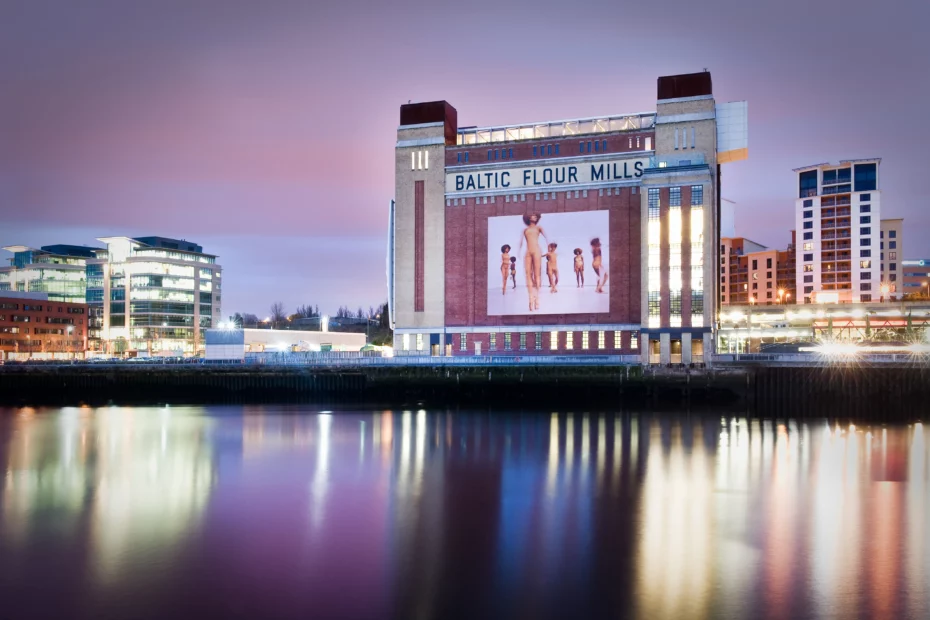The welcome page for our Levelling Up resources for local authorities
This collection of resources is designed for those working in Local Authorities (LAs) who are considering investing in their creative industries. It can be used as a portal for finding useful research and critical insights about the sector. The impetus for assembling this collection of pages is the Shared Prosperity Fund, for which LAs need to submit bids by 1 August 2022. The information we’ve compiled will continue to provide value as a bank of material to refer to when looking for advice or information, or to incentivise others to invest in the sector. Although there is a variation between the ‘Levelling Up’ funds and which local authorities can apply, our hope is that these pages are useful wherever in the United Kingdom you are based.
The Creative Industries are big business, contributing £115.9bn to the UK economy (pre-pandemic figure). This huge potential for growth is recognised by the Government, who will later this year launch a Sector Vision, setting out their aspirations for the creative industries over the next ten years.
Clusters of creative organisation can be found across the UK, in coastal and rural areas, as well as in the more traditionally imagined large urban centres. Not only do they represent huge economic potential they also enrich life quality and support community cohesion.
We want this collection of pages to be an evolving resource. We welcome any input on further examples of case studies and valuable research – let us know what we’re missing. Within relevant sections we’ve included a note on how to share your experience.
Thank you to Nerys Evans, seconded from UKRI, and to Gail Caig at the Creative Industries Council for their support in pulling together this resource.
This collection includes:
-
Case studies showing successes and learning points from projects
-
How to find out more about the creative sector in your community
-
Learning points from the UKRI’s Creative Clusters Programme, from Andrew Chitty, Challenge Director
Image credit: Lorna Simpson – The Baltic Centre for Contemporary Art in Gateshead
Further reading and references
A First Look at Connections Between the Bresence of Creative Industries and the Wider Urban Economy (2020)
Description: Uses Business Structure Database to build a 21-year data set for UK cities exploring connections between the creative industries and wider economy.
Authors: Gutierrez-Posada, D. and Nathan, M. Creative Industries Policy and Evidence Centre, CityREDI University of Birmingham and UCL.
https://www.pec.ac.uk/blog/a-first-look-at-connections
How to reference: Gutierrez-Posada, D. and Nathan, M. (2020) A first look at connections between the presence of creative industries and the wider urban economy, Creative Industries Policy and Evidence Centre, CityREDI University of Birmingham and UCL.
_________________________________________
Createch Activity in the UK (2021)
Description: An analysis of businesses at the nexus of creative and tech: who they are, where they work and what they need.
Author: Mateos-Garcia, J.
https://pec.ac.uk/research-reports/createch-activity-in-the-uk
How to reference: Mateos-Garcia, J. (2021) Createch Activity in the UK. Creative Industries Policy and Evidence Centre and Nesta.
_________________________________________
Creative Industries Radar: Mapping the UK’s creative clusters and microclusters (2020)
Description: New approach to understanding clustering of UK creative businesses via the websites of 200,000 firms.
Authors: Siepel, J., Camerani, R., Masucci, M., Velez Ospina, J., Casadei, P. and Bloom, M. Multiple: Creative Industries Policy and Evidence Centre and The University of Sussex
https://pec.ac.uk/research-reports/creative-radar
and interactive map available from:
How to reference: Siepel, J., Camerani, R., Masucci, M., Velez Ospina, J., Casadei, P. and Bloom, M. Multiple: (2020) Creative Industries Radar: Mapping the UK’s creative clusters and microclusters; Creative Industries Policy and Evidence Centre and The University of Sussex
_________________________________________
Creative Places: Growing the creative industries across the UK (2021)
Description: Briefing paper setting out how policymakers can better support and understand the creative industries.
Authors: Burger, C., Easton, E., and Bakhshi, H. (2021). Creative Industries Policy and Evidence Centre
https://pec.ac.uk/policy-briefings/resilience-in-places-growing-the-creative-industries-across-the-uk
How to reference: Burger, C., Easton, E., and Bakhshi, H. (2021) Creative Places: Growing the creative industries across the UK; Creative Industries Policy and Evidence Centre
_________________________________________
Insights from our industry champions: How policymakers can support local growth in the creative industries (2020)
Description: Write-up from panel with industry champions on impact of Covid-19, partnering with All Party Parliamentary Group for Creative Diversity
Authors: Easton, E. and Burger, C. (2020) London: Creative Industries Policy and Evidence Centre. Available from:
https://pec.ac.uk/policy-briefings/the-impact-of-covid-19-on-diversity-in-the-creative-industries
How to reference: Easton, E. and Burger, C. (2020), Insights from our industry champions: How policymakers can support local growth in the creative industries, Creative Industries Policy and Evidence Centre.
_________________________________________
Meta-evaluation of Arts Council England-funded Place-based Programmes (2021)
Description: An evaluation of six ACE-funded place-based programmes pointing to actionable lessons to inform future place-based programme policy.
Authors: Lee, B., Nott, C.
How to reference: Lee, B., Nott, C. (2021) Meta-evaluation of Arts Council England-funded place-based programmes. Arts Council England and Shared Intelligence.
_________________________________________
Mind the Gap: Regional Inequality in the UK’s Creative Industries (2019)
Description: Using DCMS Economic Estimates, this paper examines the distribution and growth of the Creative Industries in the UK at the regional level.
Author: Tether, B
How to reference: Tether, B (2019) Mind the gap: Regional inequality in the UK’s creative industries. London: Creative Industries Policy and Evidence Centre and the University of Manchester.
_________________________________________
Placemaking, Culture and Covid. Insights from our Industry Champions (2021)
Description: Insight and policy recommendations from creative industry champions on development and sustainability of ‘creative places’
Author: MacFarlane, T
https://pec.ac.uk/policy-briefings/placemaking-culture-and-covid
How to reference: MacFarlane, T (2021), Placemaking, culture and Covid. Insights from our Industry Champions, Creative Industries Policy and Evidence Centre and Centre for Cultural Value
_________________________________________
Place matters: Greater Manchester, Culture and ‘Levelling up,’ (2021)
Description: A consideration of how partnerships between local government and the cultural sector in Greater Manchester facilitated place-based responses to the impacts of the pandemic.
Authors: Dunn, B., Gilmore, A. Centre for Cultural Value, Available from: https://www.culturehive.co.uk/CVIresources/place-matters-greater-manchester-culture-and-levelling-up/
How to reference: Dunn, B., Gilmore, A. (2021) Place matters: Greater Manchester, Culture and ‘Levelling up; Centre for Cultural Value
_________________________________________
Review of the Cultural Compacts Initiative. Arts Council England and BOP Consulting (2020)
Description: Review of the initiative concluding with five key considerations for ACE, stakeholders and the Compacts themselves
Authors: Moretto, M., Owens, P., Kuhn, R.
How to reference: Moretto, M., Owens, P., Kuhn, R. (2020), Review of the Cultural Compacts Initiative. Arts Council England and BOP Consulting.
_________________________________________
The Austerity Decade: Local Government Spending on Culture (2021)
Description: Paints a nuanced picture of LA spending on cultural services after a decade of ‘austerity’.
Authors: Rex, B. and Campbell, P.
https://www.pec.ac.uk/blog/the-austerity-decade-local-government-spending-on-culture
How to reference: Rex, B. and Campbell, P. (2021) The austerity decade: local government spending on culture. London: Creative Industries Policy and Evidence Centre, University of Warwick and University of Liverpool.
_________________________________________
The European Capital of Culture: A Review of the Academic Evidence (2021)
Description: The first paper to synthesise research on the impact of the capital of culture programme on local authorities. It challenges some of the assumptions on the positive economic benefits for local economies.
Authors: Nermod, O., Lee, N. and O’Brien, D
How to reference: Nermod, O., Lee, N. and O’Brien, D (2021) The European Capital of Culture: A review of the academic evidence. London: Creative Industries Policy and Evidence Centre, London School of Economics and University of Edinburgh.
_________________________________________
The Relationships Between Cultural Organisations and Local Creative Industries in the Context of a Cultural District (2022)
Description: Explores interaction between large cultural organisations and creative businesses suggests interventions should focus on supporting more formal networks to see greater collaboration and positive economic impacts
Authors: Vartapetova, N., Fisher-Jones, H, Lam, C.
https://pec.ac.uk/discussion-papers/cultural-districts
How to reference: Vartapetova, N., Fisher-Jones, H., Lam, C. (2022). Creative Industries Policy and Evidence Centre and AEA Consulting.
_________________________________________
Valuing Culture and Heritage Capital: A framework towards informing decision making (2021)
Description: Sets out the DCMS ambition to develop a formal approach to valuing culture and heritage assets
Authors: Sagger, H., Philips, J., Haque, M.
How to reference: Sagger, H., Philips, J., Haque, M. (2021). Valuing Culture and Heritage Capital: A framework towards informing decision making, Department of Culture, Media and Sport
_________________________________________
When Policy meets Place: ‘Levelling up’ and the Culture and Creative Industries (2021)
Description: Part of the PEC’s Creative Places campaign, calling for targeted funding for creative micro clusters
Authors: Gilmore, A., Dunn., B, Barker., V, Taylor, M. (2021)
https://www.pec.ac.uk/blog/when-policy-meets-place
How to reference: Gilmore, A., Dunn., B, Barker., V, Taylor, M. (2021), When policy meets place: ‘Levelling up’ and the culture and creative industries; Creative Industries Policy and Evidence Centre
_________________________________________
Place Based Approaches to Research Funding (2021)
Description: Part of the British Academy’s work on Arts, Humanities and Social Sciences and their role in supporting place based policy
Authors: The British Academy
https://www.thebritishacademy.ac.uk/documents/3242/Place-Based-Approaches-Research-Funding.pdf
How to reference: The British Academy (2021), Place based approaches to research funding
_________________________________________
Hipsters vs. Geeks? Creative workers, STEM and innovation in US cities (2020)
Description: Research shows that those city regions are most innovative that have a high share of both creative and STEM workers, due to fusion of arts and science skills
Authors: Rodríguez-Pose, A and Lee, N
http://eprints.lse.ac.uk/103974/1/Cities_2020_PEEG_version.pdf
How to reference: Rodríguez-Pose, A and Lee, N (2020), Hipsters vs. Geeks? Creative workers, STEM and innovation in US cities
_________________________________________
The Fusion Effect: The economic returns to combining arts and science skills (2016)
Description: This paper shows that firms combining these arts and science skills are more likely to grow in the future, are more productive, and are more likely to produce radical innovations.
Authors: Siepel, J, Camerani, R, Pellegrino, G, Masucci, M
How to reference: Siepel, J, Camerani, R, Pellegrino, G, Masucci, M (2020), The Fusion Effect: The economic returns to combining arts and science skills; Nesta
_________________________________________
Supporting the Creative Industries: The Impact of the ‘Preston Model’ in Lancashire (2022)
Description: Sets out that the ‘Preston Model’ of strengthening supply chains through local procurement by anchor institutions, like local government and universities could support creative economy microclusters .
Authors: Whyman, P, Wright, A, Lawler, M, Petrescu, A
https://pec.ac.uk/research-reports/the-impact-of-the-preston-model-in-lancashire
How to reference: Whyman, P, Wright, A, Lawler, M, Petrescu, A (2022), Supporting the Creative Industries: The Impact of the ‘Preston Model’ in Lancashire; UCLan
_________________________________________
The economic impact of universities: evidence from across the globe (2018)
Description: This paper argues that universities can be a crucial factor to local economic growth.
Authors: Valero, A and Van Reenen, J
http://eprints.lse.ac.uk/90227/
How to reference: Valero, A and Van Reenen, J (2018), The economic impact of universities: evidence from across the globe; Economics of Education Review, 68. pp. 53-67
_________________________________________
Mapping and examining the determinants of England’s rural creative microclusters (2022)
Description: Sets out opportunities for supporting development of creative industries microclusters in rural areas and towns, showing the importance of existing cultural institutions and local universities offering creative subjects.
Authors: Velez-Ospina, J, Siepel, J, Rowe, F, Hill, I
https://pec.ac.uk/research-reports/rural-creative-microclusters
How to reference: Velez-Ospina, J, Siepel, J, Rowe, F, Hill, I (2022), Mapping and examining the determinants of England’s rural creative microclusters; National Innovation Centre Rural Enterprise (NICRE), Creative Industries Policy and Evidence Centre
_________________________________________
Blog: Levelling Up: how we’re helping UK businesses to build through IP(2022)
Description: Blog post by the Intellectual Property Office (IPO) showing that intellectual property as an important driver of intangible assets and how the IPO can support regional growth through this
Authors: Intellectual Property Office (IPO)
https://ipo.blog.gov.uk/2022/03/29/levelling-up-how-were-helping-uk-businesses-to-build-through-ip/
How to reference: Intellectual Property Office (2022), Blog: Levelling Up: how we’re helping UK businesses to build through IP
_________________________________________
Related News and Press
Bolster business and financial support for creative industries micro firms to achieve UK innovation and growth ambitions
New Creative PEC research suggests creative industries micro firms have a vital role to play in driv…
Back the creative industries to grow the economy, says new research showing creative firms are more likely to be innovators and exporters
New research finds a higher share of UK creative MSMEs are exporters compared with the rest of the e…


